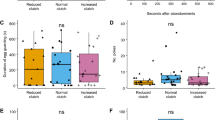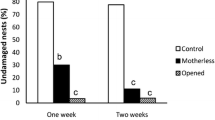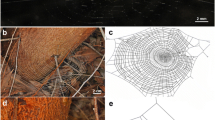Abstract
We performed laboratory experiments to study maternal care in Doru lineare Eschs. (Dermaptera: Forficulidae), a predator of the maize pest Spodoptera frugiperda J.E. Smith (Lepidoptera: Noctuidae). Females laid 29.7 ± 8.43 (SD) eggs which took 7–10 days to hatch. Mothers searched for an appropriate nest, where they cleaned and defended eggs and nymphs. Females did not recognize eggs from other females as foreign and adopted them. Other evidence of maternal behavior was also observed, such as egg-cleaning, nest-cleaning, and a lower viability of eggs not cared for by females.





Similar content being viewed by others
References
Briscoe A, Chittka L (2001) The evolution of color vision in insects. Ann Rev Entomol 46:471–510
Cônsoli FI, Parra JRP (1997) Produção in vitro de parasitóides: criação de Trichogramma galoi e T. pretiosum no Brasil. In: Parra JRP, Zucchi RA (eds) Trichogramma e o controle biológico aplicado. FEALQ, Piracicaba, pp 121–150
Costa JT (2006) The other insect societies. The Belknap Press of Harvard University Press, Cambridge
Cruz I (1991) Potencial de Doru luteipes como predador de Spodoptera frugiperda em condições de campo. Relatório Técnico Anual do Centro Nacional de Pesquisa de Milho e Sorgo 1985/1987. Sete Lagoas 4:85–86
Cruz I, Turpin FT (1982) Efeito de Spodoptera frugiperda em diferentes estádios de crescimento da cultura do milho. Pesq Agrop Brasileira 17:355–359
Cruz I, Alvarenga CD, Figueiredo PEF (1995) Biologia de Doru luteipes (Scudder) e sua capacidade predatória de ovos de Helicoverpa zea (Boddie). An Soc Entomol Brasil 24:273–278
Dib H, Jamont M, Sauphanor B, Capowiez Y (2011) Predation potency and intraguild interactions between generalist (Forficula auricularia) and specialist (Episyrphus balteatus) predators of the rosy apple aphid (Dysaphis plantaginea). Biol Control 59:90–97
Fulton BB (1924) Some habits of earwigs. Ann Entomol Soc Am 17:357–367
Gassen DN (1986) Parasitos, patógenos e predadores de insetos associados à cultura do trigo. EMBRAPA/CNPT, Passo Fundo
Gravena S (1992) Controle biológico no manejo integrado de pragas. Pesq Agrop Brasileira 27:282–299
Jamet C, Caussanel C (1995) Données biologiques, fonctionnement des apareils génitaux, comportements sexuels et maternels chez Euborellia annulipes (Lucas) (Demaptère, Carcinophoridae). Bull Soc Entomol France 100:37–58
Jarvis JJ, Haas F, Whiting M (2004) Phylogeny of earwigs (Insecta: Dermaptera) based on molecular and morphological evidence: reconsidering the classification of Dermaptera. Syst Entomol 30:442–453
Kamimura Y, Iwase R (2010) Evolutionary genetics of genital size and lateral asymmetry in the earwig Euborellia plebeja (Dermaptera: Anisolabididae). Biol J Linn Soc 101:103–112
Klostermeyer EC (1942) The life history and habits of the ring-legged earwig, Euborellia annulipes (Lucas) (Order Dermaptera). J Kansas Entomol Soc 15:13–18
Kölliker M (2007) Benefits and costs of earwig (Forficula auricularia) family life. Behav Ecol Sociobiol 61:1489–1497
Kölliker M, Vancassel M (2007) Maternal attendance and the maintenance of family groups in common earwigs (Forficula auricularia): a field experiment. Ecol Entomol 32:24–27
Lamb RJ (1976) Parental behavior in the Dermaptera with special reference to Forficula auricularia (Dermaptera: Forficulidae). Can Entomol 108:609–619
Lamb RJ, Wellington WG (1974) Techniques for studying the behavior and ecology of the European earwig, Forficula auricularia (Dermaptera: Forficulidae). Can Entomol 106:881–888
Lamb RJ, Wellington WG (1975) Life history and population characteristics of the European earwig, Forficula auricularia (Dermaptera: Forficulidae), at Vancouver, British Columbia. Can Entomol 107:819–824
Leite LG, Lara FM (1985) Flutuação populacional de insetos e inimigos naturais associados à cultura da soja em Jaboticabal, SP. An Soc Entomol Brasil 14:45–57
Martin P, Bateson P (2007) Measuring behaviour, an introductory guide. Cambridge University Press, Cambridge
Meunier J, Wong JWY, Gómez Y, Kuttler S, Röllin L, Stucki D, Kölliker M (2012) One clutch or two clutches? Fitness correlates of coexisting alternative female life-histories in the European earwig. Evol Ecol 26:669–682
Miller JS, Zink AG (2012) Parental care trade-offs and the role of filial cannibalism in the maritime earwig, Anisolabis maritime. Anim Behav 83:1387–1394
Miller JS, Rudolph L, Zink AG (2011) Maternal nest defense reduces egg cannibalism by conspecific females in the maritime earwig Anisolabis maritime. Behav Ecol Sociobiol 65:1873–1879
Munoz NE, Zink AG (2012) Asymmetric forceps increase fighting success among males of similar size in the maritime earwig. Ethology 118:1–12
Pasini A, Parra JRP, Lopes JM (2007) Dieta artificial para criação de Doru luteipes (Scudder) (Dermaptera: Forficulidae), predador da lagarta do cartucho do milho, Spodoptera frugiperda (J.E. Smith) (Lepidoptera: Noctuidae). Neotrop Entomol 36:308–311
Pasini A, Parra JRP, Nava DE, Butnariu AR (2010) Exigências térmicas de Doru lineare Eschs. e Doru luteipes Scudder em laboratório. Ciência Rural 40:1562–1568
Patel PN, Habib MEM (1978) Biological and behavioral studies of an oviparous earwig, Marava arachidis Yersin 1860 (Dermaptera: Forficulidae). Rev Biol Trop 26:385–389
Radl RC, Linsenmaier KE (1991) Maternal behaviour and nest recognition in the subsocial earwig Labidura riparia Pallas (Dermaptera: Labiduridae). Ethology 89:287–296
Rankin SM, Storm SK, Pieto DL, Risser AL (1996) Maternal behavior and clutch manipulation in the ring-legged earwig (Dermaptera: Carcinophoridae). J Insect Behav 9:85–103
Reeve HK (1989) The evolution of conspecific acceptance thresholds. Am Nat 133:407–435
Reis LL, Oliveira LJ, Cruz I (1988) Biologia e potencial de Doru luteipes no controle de Spodoptera frugiperda. Pesq Agrop Brasileira 23:333–342
Rentz DCF, Kevan DKM (1994) Dermaptera. In: Naumann ID (ed) Systematic and applied entomology: An introduction. Melbourne University Press, Melbourne, pp 286–289
Romero-Sueldo M, Cuezzo F (2001) Presencia de Paratrechina silvestri (Hymenoptera: Formicidae) posible enemigo natural de Doru lineare (Dermaptera: Forficulidae) en cultivos de maiz. Neotropica 47:60
Romero-Sueldo M, Dode M (2002) Descripción de los estados inmaduros y ciclo de vida de Doru lineare (Dermaptera: Forficulidae) en cultivos de maíz en Tucumán (Argentina). Acta Zool Lilloana 46:71–80
Shanks CH, Finnigan BF (1973) Temperature and relative humidity effects on eggs and first-stage larvae of the black vine weevil, Otiorhynchus sulcatus. Environ Entomol 2:855–858
Shepard M, Waddill V, Kloft W (1973) Biology of the predaceous earwig Labiduria riparia (Dermaptera: Labiduridae). Ann Entomol Soc Am 66:837–841
Soares JJ, Busoli AC (2000) Efeito de inseticidas em insetos predadores em culturas de algodão. Pesq Agrop Brasileira 35:1889–1894
Soares JJ, Braz BA, Bussoli AC (1995) Impacto de Herbicidas sobre artrópodos benéficos associados ao algodoeiro. Pesq Agrop Brasileira 30:1135–1140
Staerkle M, Kölliker M (2008) Maternal food regurgitation to nymphs in earwigs (Forficula auricularia). Ethology 114:844–850
Suzuki S, Kitamura M, Matsubayashi K (2005) Matriphagy in the hump earwig, Anechura harmandi (Dermaptera: Forficulidae), increases the survival rates of the offspring. J Ethol 23:211–213
Terashima J, Bownes M (2004) Translating available food into the number of eggs laid by Drosophila melanogaster. Genetics 167:1711–1719
Vancassel M (1984) Plasticity and adaptive radiation of dermapteran parental behavior: results and perspectives. Adv Stud Behav 14:51–80
Volpato GL, Barreto RE (2001) Environmental blue light prevents stress in the fish Nile tilapia. Braz J Med Biol Res 34:1041–1045
Williams GC (1966) Natural selection, the costs of reproduction, and a refinement of Lack’s principle. Am Nat 100:687–690
Wingfield JC (2003) Control of behavioural strategies for capricious environments. Anim Behav 66:807–816
Worthington EB (1926) The life-cycle of Forficula auricularia Linn. Entomologist 59:138–142
Author information
Authors and Affiliations
Corresponding author
Rights and permissions
About this article
Cite this article
Butnariu, A.R., Pasini, A., Reis, F.S. et al. Maternal Care by the Earwig Doru lineare Eschs. (Dermaptera: Forficulidae). J Insect Behav 26, 667–678 (2013). https://doi.org/10.1007/s10905-013-9377-5
Revised:
Accepted:
Published:
Issue Date:
DOI: https://doi.org/10.1007/s10905-013-9377-5




